Curious about the cultural exhibits at the Polynesian Cultural Center?
Did you know that each island village has a number of exhibitions on how they constructed their homes and the significance of various objects in their culture?
Our six island villages of Hawaiʻi, Aotearoa, Fiji, Samoa, Tahiti and Tonga, are delighted to share more information about these exhibits while you’re exploring. We especially encourage you to ask questions and learn the details of each nation with our helpful cultural representatives present in each village.
And the great news is that you don’t have to explore them all at once.
Purchase any of our full-day packages for the Center and return the next day to wander through our island villages at your leisure. What a great opportunity to maximize your learning experience and understanding of the Polynesian cultures.
In this blog, I’ll introduce you to the cultural exhibits currently available in each village.
Cultural exhibits in our Samoa Village
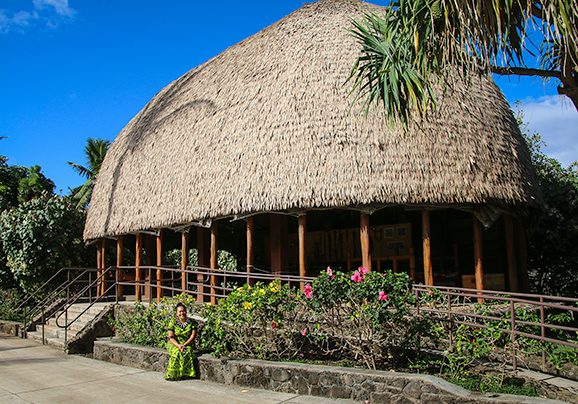
The māota, or chief’s house in the Samoa Village
When you enter the Samoa Village, you’ll see the exact style of huts (fale) that you would find in a typical village setting. But these fale are far more than just simple dwellings—they’re a source of life and culture for the people of Samoa.
The huts consist of the Tunoa/Umukuka (Kitchen), Fale Nofo (Family Dwelling), Fale Talimālō (Guest House), and Māota (Chief House).
The Chief’s House is the most prestigious building. You can enter it only by invitation from the chief. It is the only building with a raised foundation, portraying the respect that both the village and families have for their leader.
Cultural exhibits in our Aotearoa Village
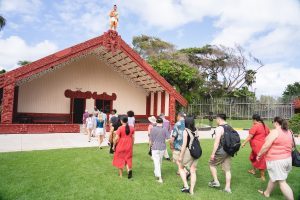
The Hawaikiroa building in the Aotearoa Village
Our Aotearoa Village offers you a chance to learn about the history and culture of the Māori people.
Upon entering the Aotearoa Village, you’ll find a marae—a focal point of Māori culture. Meetings, celebrations, burials, educational workshops, and other significant tribal events frequently take place at these community centers.
One of the most prominent buildings in the marae is Hawaikiroa, the ancestral meeting house, where you can enjoy the passionate and exciting Māori cultural presentation. This house personifies the ancestor Hawaikiroa, with representations of his physical anatomy. The exterior displays his head, shoulders, and outstretched arms, hands and fingers; a welcome gesture to visitors. The interior rafters feature a display of his backbone and rib cage. Stylized carved figures, positioned around the room, represent many of his notable descendants.
You shouldn’t miss out on our other cultural exhibits!
- Te Whare o Te Toa (House of the Warrior)
- Kia Ngāwari Tātai Arorangi Exhibit (Astronomy)
- Te Ikaroa-ā-Māui – Waka Taua (War Canoe)
- Kupe Toi Whakairo Exhibit (The Art of Carving)
Cultural exhibits in our Fiji Village
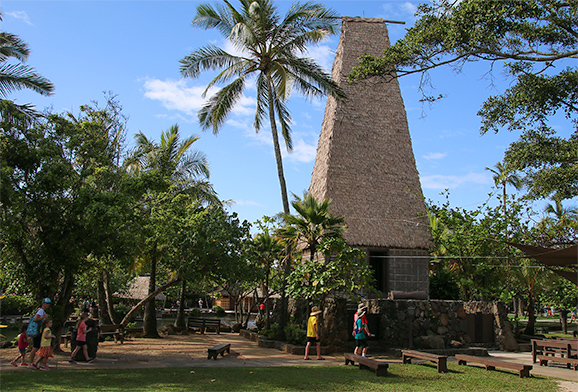
The Bure Kalou or “Spirit House” in the Fiji Village is as tall as a 6 story building
Our Fiji Village introduces you to six distinct cultural displays and each represent different aspect of the Fijian culture.
The Bure Kalou, also referred to as the “Spirit House,” is a pre-Christian Fijian house of worship or temple. Due to its longstanding custom of sheltering the ancestor gods, it is consistently the tallest structure in the village.
Children go to Vale Ni Qase, also known as the “Old Folk’s House,” to learn about family customs from their grandparents.
The home of the chief is the Vale Levu. This spacious building is elevated above every other construction except bure kalou.
The Vale Ni Bose, or Meeting House, acts as the hub for community ceremonies.
The Camakau is a Fijian wooden outrigger canoe. It is a fast and highly maneuverable outrigger sailing canoe used to travel among the islands of Fiji.
Cultural exhibits in our Tahiti Village

Travel back in time in the Tahiti Village
When you visit our Tahiti Village, you’ll discover five unique cultural exhibits unique to these islands.
First, you can’t miss the Marae (Outdoor Temple) where a traditional Tahitian wedding ceremony is performed. The ceremony is also opened to guests who wish to reaffirm their fidelity and love to their partner.
Afterwards, head over to the Fare Pote’e where you can learn more about arts and crafts made by Tahitians. It’s truly incredible how much talent these people have!
Next up is the Fare Heiva where you can watch dancers perform the renowned Ori Tahiti dance and learn more about the islands’ history. This exhibit will give you insights into Tahitian culture and traditions.
To sample some authentic Tahitian coconut bread, visit the Fare Tutu, or outdoor kitchen.
Last but not least, go fishing at Fale Tautai, also referred to as the Tahitian Fishing Hut.
Cultural exhibits in our Hawaiʻi Village
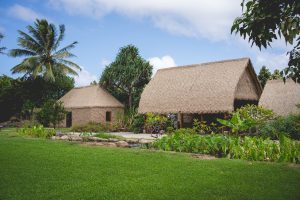
Hawaiʻi is a place of calm and tranquility designed to emphasize the spirit of ʻaloha
When it comes to Hawaiian culture, there’s no better place to learn than in our Hawaiʻi Village. There are six distinct displays that will greet you as you enter our village. We encourage you to take note of the architectural styles and the history behind each of these buildings.
First, visit Hale Aliʻi, which means “Chief’s House.” This is where the chief would conduct meetings and councils with his tribe members.
Next up is Hale Mua (Men’s Eating House). Men and women were not permitted to eat together in Hawaiʻi prior to 1820 because of the ʻAi Kapu (eating law) that all subjects were required to follow under Aliʻi rule.
Then there’s Hale Lawaiʻa known as the Fishing House, which served as a building to construct and store all fishing equipment.
Want to see the house where the family used to sleep? Visit the Hale Noho/Noa.
If you’re interested in learning more about the famous Hawaiian hula (dance), then definitely check out the Hale Hālau (House of Learning).
Want to learn about intricate Hawaiian arts and crafts? The Hale Ulana (Weaver’s House) is a worthwhile visit.
Cultural exhibits in our Tonga Village
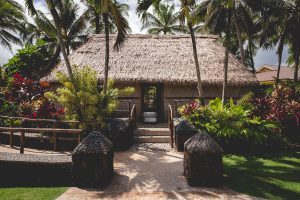
Queen Salote’s Summer House in the Tonga Village
Discover the magnificent Tonga Village, and be amazed by the different buildings that represent traditional historical architecture in a typical Tongan community.
Don’t miss out a chance to see the replica of the Fale Fakatu’i ‘a Tupou III (Queen Salote’s Summer House), which is considered the most prominent building.
Head over to Fale Faka-Kolo (Meeting House), where all meetings and formal kava ceremonies take place.
You can also visit the Fale Hanga (ngatu making building) to learn about the craft of making authentic Tongan tapa.
If you want to know where the family resides, stop by the ‘Api Nofo’anga (Family Dwelling).
Now you know the basic information regarding the cultural exhibits. Realizing there is more to discover when touring the six island villages, you don’t have to find them by yourself. We have cultural ambassadors on staff who can answer your questions about the various exhibit and their cultural contexts they represent.
Don’t forget to purchase one of our full-day packages, so, you can truly immerse yourself in the six unique and inspiring cultures represented at the Polynesian Cultural Center.
Bio of Quinney Suaava, Blog Coordinator at the Polynesian Cultural Center
 My family, culture, talent, and knowledge are the things I treasure the most. And the things I love to do are spending time with the people I love, traveling to different places, cooking Samoan food, singing and playing the ukelele, learning new things about life, and the list goes on! All of these contribute to my passion, experience and love for writing.
My family, culture, talent, and knowledge are the things I treasure the most. And the things I love to do are spending time with the people I love, traveling to different places, cooking Samoan food, singing and playing the ukelele, learning new things about life, and the list goes on! All of these contribute to my passion, experience and love for writing.


Recent Comments